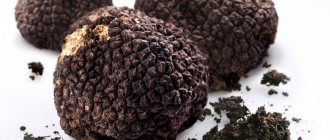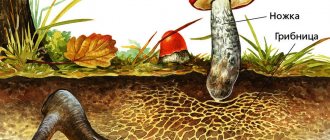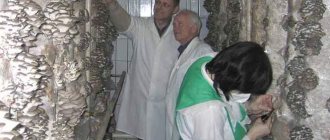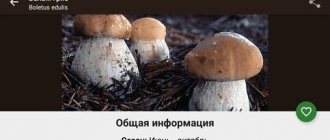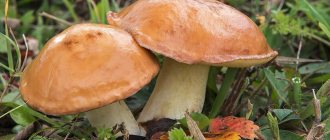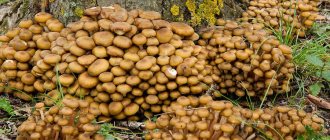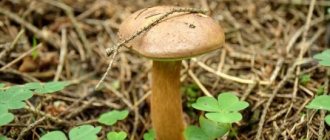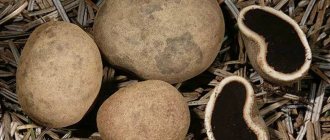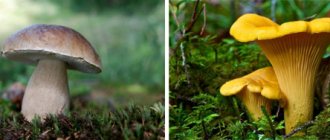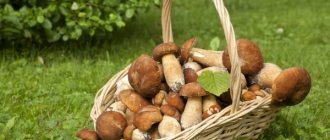Truffle is a rare delicious mushroom that grows underground. On the market, 1 kg of such mushrooms costs from 2 to 5 thousand euros; individual specimens were sold for more. The high cost is determined by the difficulty of obtaining the mushroom and high demand. High demand due to its extraordinary taste, which even a strict critic will appreciate.
Mushrooms grow in hard-to-reach places, underground 10-15 cm under the roots of trees, which complicates their search. The location of mushrooms depends on the composition of the soil and climate. You need to look for them in the roots of poplar, linden, rowan, oak, beech, birch, from this we can conclude that the fungus chooses mixed and deciduous forests.
Characteristics
Specimens do not grow on the surface, but at a depth of 15 cm or even half a meter. They look fleshy bodies, not exactly attractive in appearance, but their wonderful aroma of the autumn forest is remembered for a long time.
The mycelium fills:
- Hornbeams;
- Oak;
- Poplar;
- Linden roots.
The location under elms, mountain ash, and hawthorn is also favored. Parasitic fungi feed on woody elements, but do not harm trees.
Moscow, Oryol, Vladimir, Samara, Leningrad regions are the areas where truffles grow in Russia.
It is also worth noting the Caucasus, the Volga region, Crimea, and the Black Sea coast.
A little history
150 years ago, the summer truffle was much more common. Peasants of the Podolsk, Moscow, Pskov, Tula, Oryol, and Belgorod regions were engaged in collecting and selling it. This is described in an article in the magazine “New Time” dated 1902.
In Crimea, the first reliable mention of this mushroom is in the note of N.K. Sretinsky “Materials for the flora of the Novorossiysk region and Bessarabia” dated 1874.
The most serious known source is the monograph of the Russian mycologist F.V. Buchholz “Materials on the morphology and semantics of underground fungi” (1902).
Appearance of truffle
Round, tuberous specimens are characterized by a fleshy cartilaginous consistency. In size they resemble a nut or potato tuber and are covered with a leathery layer of peridium. This is a smooth substance or with cracks and warts. When cut, a marble pattern appears. Inside there is an alternation of light and dark veins.
The reproduction of underground invisible creatures is facilitated only by wild animals, which eat them with great pleasure; fungal spores remain in excrement, becoming the basis of future generations.
Tuber Aestivum Extract in cosmetics
Due to the presence of minerals and amino acids, Tuber Aestivum Extract is highly valued in cosmetology and is one of the most effective and expensive ingredients. Its active ingredients help:
- in the fight against wrinkles;
- improve complexion;
- remove swelling and redness;
- restore skin after peeling and plastic surgery;
- stimulate the production of elastin and collagen;
- heal the hair structure and activate its growth.
The extract is used to produce skin care products for the face, hands, body (creams, serums, foundation, oil ampoules, moisturizers) and hair (shampoos, balms, masks).
The main advantage of such cosmetics is safety and naturalness.
Varietal varieties
The Russian version looks like a black summer fungus with a diameter of 10 cm and a weight of almost half a kilo. The color of the flesh depends on age, ranging from beige to gray-brown.
Young fruits have a dense structure, while old ones are characterized by looseness. All of them are famous for their sweet taste and nutty or seaweed-like smell.
In areas where black truffles grow, the presence of pines, oaks, and hazels is necessary, with which their mycorrhiza is associated. The ripening season is from June to October. Mushrooms grow either alone or in groups.
- The southwest of Russia and the Black Sea coast can also boast of such specimens.
- Winter blacks have larger parameters, sometimes exceeding a kilogram.
- They are reddish-violet in color, turning black after cutting.
- Growing points: Ukraine, France, Italy, Germany, Portugal.
- Fruiting spans November-March, and the aroma of rarities has musky notes. If there are heavy rains, the mushroom may roll out on its own.
These representatives of the flora prefer soils saturated with lime and calcium. The places where the white truffle grows in the Russian Federation include the Smolensk, Voronezh, and Kuibyshev forests.
This valuable variety is similar to Jerusalem artichoke tuber, tastes like walnuts or roasted seeds and weighs 1.5 kg. The harvesting period is July-November.
In the warm climate of Anapa, Gelendzhik, and Abrau-Durso, the chance of finding the delicacy increases, although the Tomsk region also sets records for its collection. In Europe, the most in demand are the Italian Piemeni variety, which is similar to a turnip, and the Périgord French black diamond.
Son of Lightning
Truffle mushroom - a fragrant earthen treasure
In Italy, where truffles have been sought and loved for thousands of years, there is a belief that these mushrooms grow where lightning strikes the ground.
These mushrooms were known back in Ancient Egypt, from where the culture of their use migrated to the curious and loving Romans. They actively purchased desert and steppe truffles from North Africa and the Middle East. Whether it was already known then that these mushrooms grew in Europe itself has not yet been reliably established. After the fall of the Empire and the capture of the southern and eastern territories by wild Arabs, the supply of truffles to Europe dried up, and several more centuries passed before Europeans learned to find this underground mushroom in their homeland.
Truffle mushroom - aromatic earthy treasure
Truffle hunting in Western Europe appeared in the late Middle Ages, and since then has never stopped. The great historian Umberto Eco, in his novel The Name of the Rose, talks about how, at the beginning of the fourteenth century, stern Catholic monks went truffle hunting in the company of a pig.
Since the middle of the 19th century, these mushrooms began to be grown artificially in Europe in order to satisfy the needs of all thirsty gourmets.
Silent hunt
Detecting mushrooms requires some knowledge. They adore the moist black earth soil, and the smell reaches its climax at night. Nuances you should know:
- Near truffle deposits there is always stunted vegetation and gray-ashy soil.
- Remember about the deep location, so dig out all the mounds you encounter.
- Over the rich location there is a cluster of a swarm of red midges, laying eggs here.
- They take with them trained dogs or pigs, which sense samples a couple of tens of meters away and clearly follow them, starting to dig.
Go into the forest with beech, birch, and oak trees, passing by clearings that are unsuitable for growth. If your assistant is a pig, put a muzzle on her, otherwise the prey will be immediately eaten.
Dig up the fruiting body carefully, ensuring that the remains continue to live.
The information provided will help you decide where the truffle grows and how to look for it.
How to identify false duplicates?
Mushroom lovers should remember that the black summer truffle has inedible counterparts. They are very dangerous to human health. These mushrooms include:
- Reindeer truffle;
- False truffle;
- some types of Steppe truffle.
These mushrooms belong to completely different families, and, despite the external similarity, you can see their differences (see photo). Most often, false truffles end up in the basket of inexperienced mushroom pickers.
| Reindeer truffle | Grows in the forests of Europe and North America. Causes abdominal pain and indigestion. |
| False truffle | Dangerous to human life. Belongs to the family of basidiomycetes. It is dark red or beige in color and has an oblong shape. |
| Some types of Steppe truffle | Grows in Turkmenistan, Azerbaijan, North Africa, Southern Europe. Its fruiting body is located on the surface, forming a mushroom in the form of a tuber. |
Important! At the first signs of poisoning, you should immediately seek medical help.
Home growing process
Wanting to become the owner of a delicacy, it is bred at home.
- It is taken into account that the mycelium does not tolerate temperature changes, taking root only in a suitable microclimate.
- They buy tree species whose roots are charged with mycelium; they will cost from $10.
- Trees are planted in an area not blown by the wind and protected from the scorching rays of the sun.
- Do not use any fertilizers first; they can kill the substrate.
Planting is carried out in the spring, when the weather stabilizes. The hole is dug in proportion to the root system, water is first poured into it, and then the crop is placed. The stamp is covered with oak leaf mulch and covered with greenhouse film.
Interesting information
Unique specimens were first mentioned in written sources of 1600-1700. BC e. In the Middle Ages they were credited with magical powers. The ancient Romans baked them over coals and ate them with honey, which was believed to enhance libido.
According to the current hypothesis, mature samples contain a molecule of happiness, anandamide, which is a psychotropic substance that improves mood. In addition, the fragrant smell is a strong aphrodisiac.
- In the 19th century, 1000 tons of product were collected, today production has decreased to 50 thousand.
- China is a major manufacturer; its products are cheaper, but not of good quality.
- Holding Italian autumn truffle fairs in Alba has become a tradition that annually brings together gourmets from all over the planet.
- The largest edible giant gained a mass of almost 2 kg.
Photos of places where truffles grow confirm that they prefer deciduous or mixed forests and groves with conifers. Exotics are listed in the Russian Red Book.
Artificial Cultivation
Truffle mushroom - a fragrant earthen treasure
The most prized types of truffles in cooking are Piedmontese, Perigord and winter, growing in beech and oak groves in the South of France, Northern Italy and Switzerland.
The mushroom's deep, rich, walnut-like flavor and legendary aroma are prized throughout the world as a brilliant culinary delicacy.
Since the beginning of the 19th century, experiments began in Europe on the artificial cultivation of truffles by planting oak species under which these mushrooms were usually found. The experiments were expensive, but they brought results, and in France, by the end of the 19th century, 750 square kilometers were occupied by special plantations, from which up to 1000 tons of mushrooms were collected per year. From France, the culture of artificially growing truffles has spread to different parts of the world, and today it is grown not only in Europe, but also in North America, Australia, New Zealand and China.
The Chinese quickly realized the market opportunities and began to grow their own variety of mushroom, inferior to European ones in quality, but cheaper to produce. Today, China ranks first in the world in truffle production, exporting most of the mushroom produced to Europe, and mixing the Chinese product with specially purchased French ones to make it harder for European gourmets to find fault with the quality.
Useful properties and preparation
Delicious mushrooms are used to prepare pates, pie fillings, sauces and are consumed raw. They are frozen, dried and canned.
The composition has been replenished:
- Plant proteins;
- Carbohydrates;
- Vitamins B, PP, C;
- Minerals;
- Antioxidants;
- Enzymes and fiber.
Mushroom juice treats eye diseases, and the pulp cures gout.
Finding these natural uniques is a great success, which is within the reach of experienced and persistent mushroom pickers.
